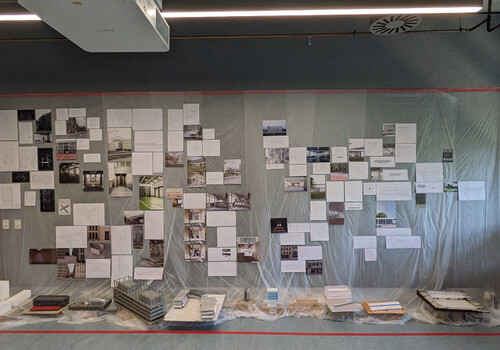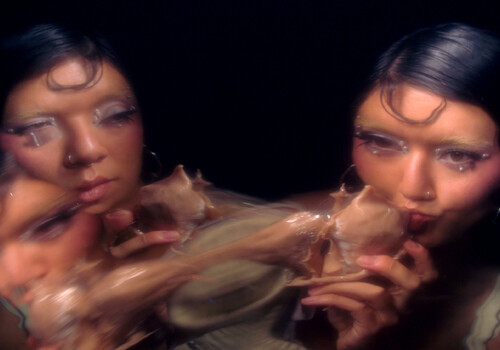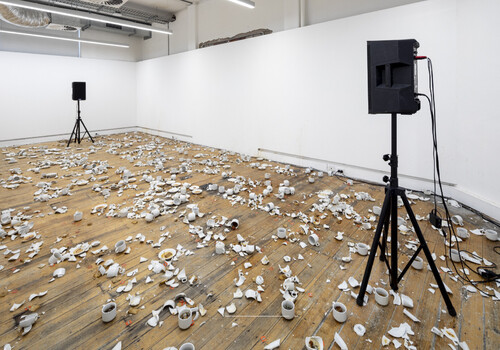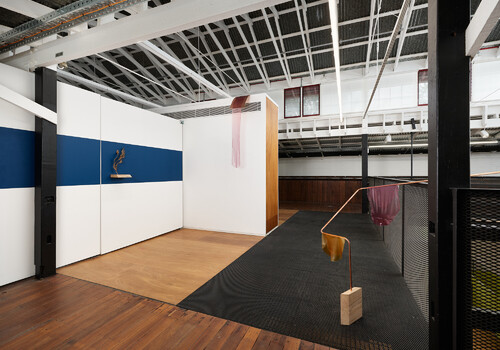Fashion, RMIT
By Ethan Langholcs

Carys Norwood, Laura Heron, Georgia Brookes, Oliver Layton, DOLL Runway, 2024. Post-show group shot. Image: Dan Crivelli
Drill Hall felt far from the Barbie dreamhouse for these dolls. Toppled over, all twenty-eight of them had fallen past the wardrobe, bar, and pool, and interrupted the ball room, which was filled by the sound of Jonah Gabriel’s score: a synthesising rendition which would ground the dolls’ dismembered states. It was as if the four student designers had spent their Honours year searching for a niche in the market, as opposed to adorning their dolls in any garments that would actually fit. Stretched-out tees, velvet ensembles that had burst at the seams, sleeveless polos, and even a mankini with no straps for the shoulders were all on display in this end-of-year showcase. There was a blatant disregard for the military uniform Drill Hall had once requested. Yet once the dolls began to march, the marionette strings of the designers’ radical intentions lustred in the spotlight.

Carys Norwood, Honours Collection Look 1 – DOLL Runway, 2024, ‘Prize’ briefs with black feather. Runway shot. Image: Steph Reid
When the lights did not dim, it seemed Carys Norwood was out of time. One angsty lost doll had found themselves wearing only a feather as a vulnerable compromise. No student was in search of such a niche as Norwood, whose collection of figurines was a twisted assortment of obscure angles. It was a subcultural encapsulation of emo archer boys wearing Nobel Prize-printed Calvin Kleins, a complex combination of jersey cuts with low-cut skinny jeans styles. The archers’ range sensitively contradicted the revived D.C. shoes. Norwood’s graceful strokes were t-shirts pulled out by arrows, shot directly at the back of her last doll’s red bull’s eye. She painted a Renaissance battlefield of sad boys who do not cry. Fallen cupids were meticulously accessorised by fletched arrows and blunt stud wounds exposing their insides. They were bandaged in hoodies: wrapped in leather scraps. An uncouth fragility was found in the hard boy demise.
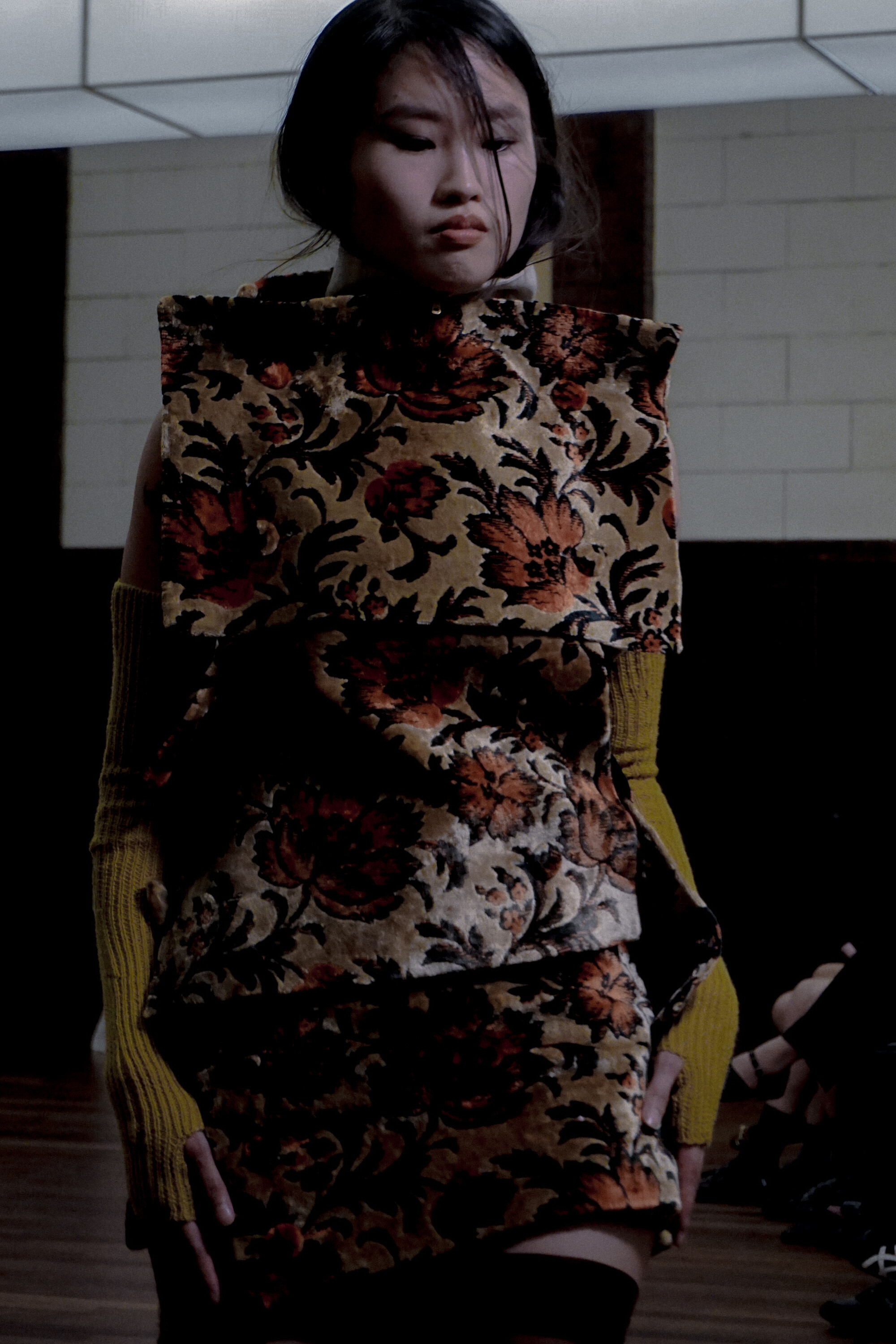
Laura Heron, Honours Collection Look 1 – DOLL Runway, 2024, repurposed upholstered bodice and skirt, with knitted sleeves. Runway shot. Image: Steph Reid
Was the next doll hiding in fear of the archers on the battlefield or the trench-coated detectives who were still to come? Laura Heron’s first doll was hiding from the runway in a stolen old chair with floral upholstery. The clothes were as if furniture was designed for wearing, with little to no darts or shaping. Heron’s flat world was a perfectly fitting statement. The garden’s edges wilted with each step, held together by a bloom of mustard yellow and cobalt blue rib sweaters that were so finely knit. Heron reinterpreted the man-made world in way that sat so eloquently. Form became delicate, not fragile or rough. Instead, laser-cut wool flowers held themselves together for the human touch. Trench coats were cropped and draped backwards in an ornamental rearrangement. It seemed life was not so still when considering lived experience of the human state.

Georgia Brookes, Honours Collection Look 4 – DOLL Runway, 2024, deconstructed screen-printed polo with knit-lined, asymmetric high waisted jeans and leather belt. Runway shot. Image: Steph Reid
For a collection so close to home, Georgia Brookes’ honest dolls were considerably out of line. She was referencing sharpie culture, yet her disproportionate lines were not sharpied but screen-printed. The impressionist polo sublimely defined a colour-blocked paradox of warped past times. Straight from the bar, her dolls unknowingly arrived half-dressed and un-styled. The denim flies were warped and off-centre. This jarred with the perpendicular flat felt seams that ran down the jeans’ sides. Custom leather cattle tags were used to define such dolls. Keep it simple. Keep it sexy. The collection was ironically etched. Varying lengths of polos stretched into a modern evening dress—sexy, but not simple. The imitation of worn-through garments felt vastly complex. The polos were tailor-made to ride up, whilst keeping the cool girl arms crossed shut.
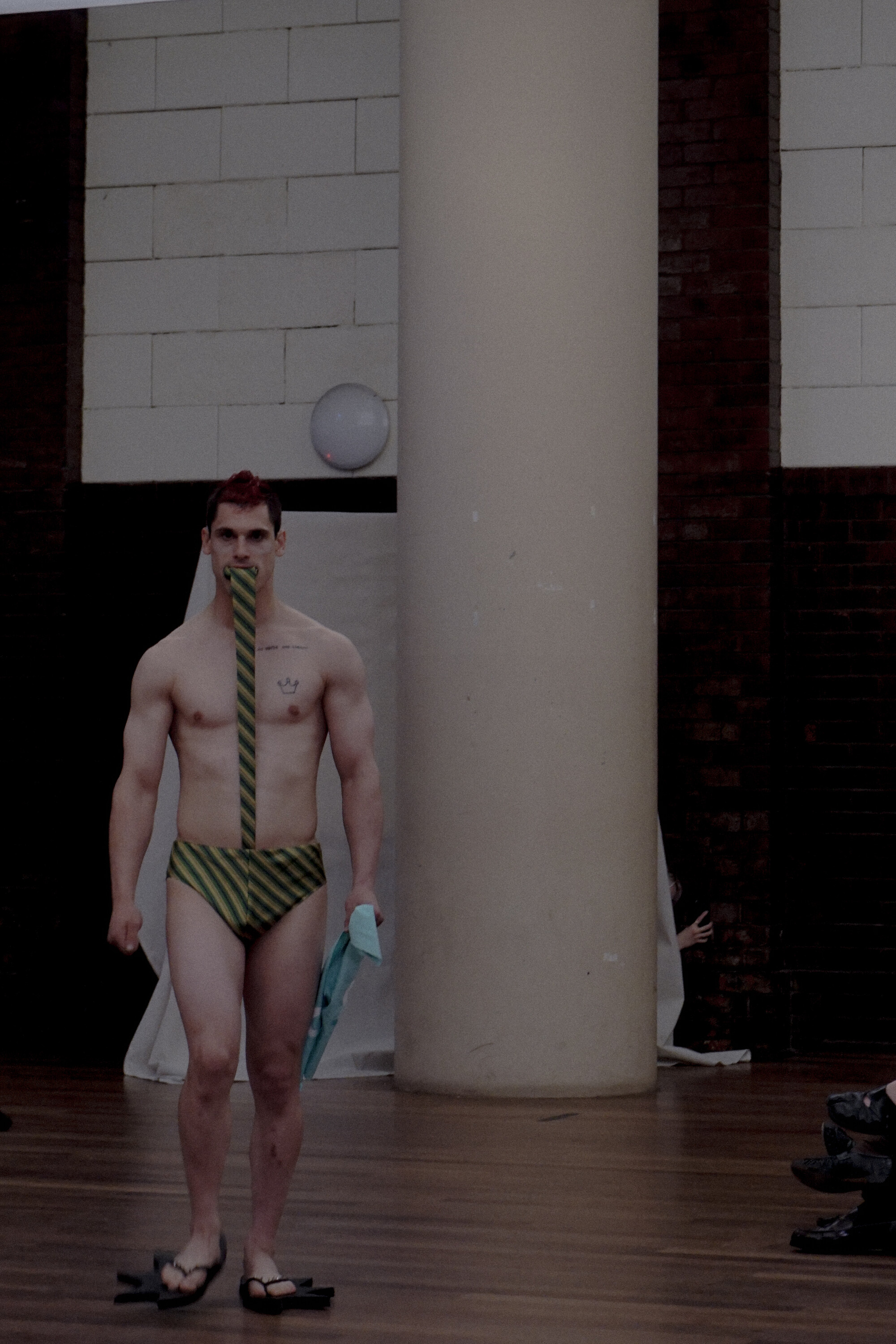
Oliver Layton, Honours Collection Look 4 – DOLL Runway, 2024, mouth-suspended swim briefs with towel and star thongs. Runway shot. Image: Steph Reid
Oliver Layton’s collection was an absurd interruption of Brookes’ sharpness. The loudest collection of hunks was heard squeaking around Drill Hall’s hidden pool floors. Layton’s debut dived headfirst into the wrong room. The crowd gasped from the sidelines at truly unique and erotic bather styles. Wacky swim caps of an alien kind had washed up. Layton’s calling took deconstructed tailoring to new depths, such that they could be considered as serious designs. Some dolls wore towel-wrapped jackets with lapels. Others were left to bare it all, except for a mouthful of speedo shirt ties. They were accessorised by the convoluted memorabilia crashing against the pool side. Innately dysfunctional, the designs were instead a look inside the swimmer’s mind. Layton’s hybrid bathers’ styles capture all the motions in spandex, leaving no part of the pool behind.
In a last call, the dolls all marched for one final round. It became apparent that the show was no drill for the toppled-over dream house. The marionettists emerged all proud, bowing to the applause of the ecstatic crowd.
Ethan Langholcs is a fashion writer and designer based in Naarm/Melbourne






